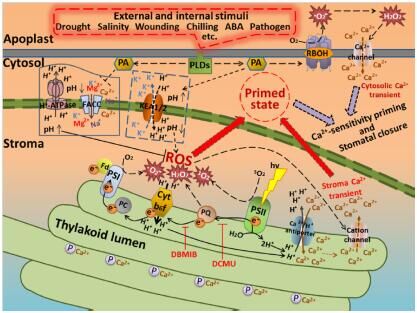作 者:Wang, WH; He, EM; Guo, Y; Tong, QX;Zheng, HL影响因子:3.358
刊物名称:Environmental and Experimental Botany
出版年份:2016
卷:122 页码:85-93
Plant signaling networks have evolved adaptive mechanisms that enable the rapid response of stomata to the multiple abiotic and biotic stresses. These signaling networks are not simply chaotic but constrained and spread throughout the cellular compartments to achieve the Ca2+-sensitivity priming of guard cells. The irreplaceable role of the chloroplast as a photosynthetic apparatus in higher plant is understood; however, the contribution of chloroplast signaling dynamics to Ca2+-sensitivity priming is sometimes ignored. As a key booster of Ca2+-sensitivity priming, the primed state of guard cells is potentially related to chloroplast Ca2+and reactive oxygen species (ROS) signaling. This review will discuss the generation of chloroplast Ca2+and ROS signaling during stomatal closure under various stimuli. Here, we provide a model demonstrating the involvement of chloroplast Ca2+and the ROS signaling pathway in facilitating the primed state when plants sense a stressful environment, while addressing the roles of phospholipase D, phosphatidic acid, stromal acidification and PQ pool in the signaling networks. In addition, we summarize the recent studies on the mutants of the plant calcium sensing receptor, which could further support and develop our model.

Fig. 2.The model describes the primed state for stomatal closure through chloroplastic ROS generation and Ca2+signaling when sensing multiple stimuli. The PLD family is activated by a wide range of stimuli and induces PA generation. PA signaling promotes a causal sequence: activation of KEA1/2 or inactivation of FACC and H+-ATPase, followed by stroma acidification and by the inhibition of PET and the PQ-pool-dependent generation of chloroplastic ROS, leading to Ca2+strrelease from the thylakoid lumen (Ca2+strtransient). Chloroplastic ROS and Ca2+strtransients together achieve the primed state of guard cells and facilitate Ca2+-sensitivity priming and stomatal closure with Ca2+cyttransients, as induced by the PA/RBOH/ROS/Ca2+channel pathway on the plasma membrane. The solid arrows indicate the pathway for activating the PET, proton gradient and Ca2+/H+antiporter under favorable conditions under light. The dashed arrows reveal the signaling networks that are involved in facilitating the primed state and stomatal closure under a diversity of stimuli.

